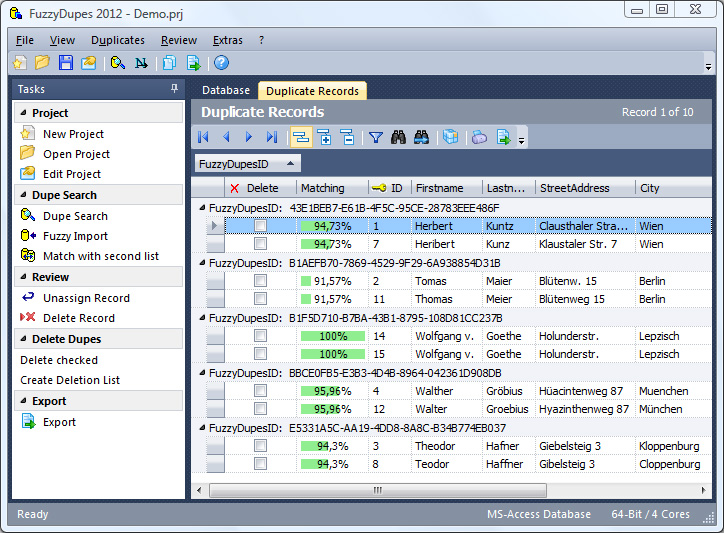Record Linkage Resources
Download whitepaper on "Approximate Duplicate Detection" which opens with the following:
Detecting database records that are approximate duplicates, but not exact duplicates, is an important task. Databases may contain duplicate records concerning the same real-world entity because of data entry errors, unstandardized abbreviations, or differences in the detailed schemas of records from multiple
databases – such as what happens in data warehousing where records from multiple data sources are integrated into a single source of information – among other reasons. In this paper we review a system to detect approximate duplicate records in a database and provide properties that a pair-wise record matching algorithm must have in order to have a successful duplicate detection system.
Download paper on probabilistic record linkage and an automated procedure to minimize the undecided-matched pair problem. Here is an introduction to this paper:
Probabilistic record linkage allows the assembling of information from different data sources. In this article, we present a procedure in case a one-to-one relationship between records in different files is expected but is not found only by applying the probabilistic record linkage methodology. Our data were births and infant deaths from the 1998-birth cohort whose mother’s place of residence was the City of São Paulo at the time of birth. Our assumption was that pairs for which a one-to-one relationship was obtained, and a best-link was found with the highest combined weight would be considered as uniquevocally matched pairs or gold-standard and should then provide information in order to decide about pairs in which such a relationship could not be established. For example, we observed that the for the unequivocally matched pairs a clear and expected relationship between differences in dates of death and birth registration could be assessed. As a result, such a relationship was used to help solving the remaining pairs for which a one-to-one relationship could not be found. Indeed, we reduced the number of non-uniquely matched records and even though we could not establish a one-to-one relationship for every single death we reduced the number of uncertain. We suggest that future research using record linkage should use combined strategies from results from first record linkage runs before a full clerical review (the standard procedure under uncertainty) in order to most efficiently (and less costly), retrieve record matches.
Applications of Record Linkage Techniques
Here is an excerpt:
Record linkage is simply the bringing together of information from two or more records that is believed to relate to the same entity, e.g., the same individual, the same family or the same business. This may entail the linking of records within a single computer file to identify duplicate records. Alternatively, record linkage may entail the linking of records across two or more files. The challenge lies in bringing together the records for the same individual entities. Such a linkage is known as an exact match. The task is easiest when 1) the files have nearly unique identification numbers (e.g., social security numbers), 2) information is recorded in standardized formats and 3) the files are small. In the absence of nearly unique identifiers, names, addresses, dates-of-birth or other indirect identifiers are frequently used in the matching process.



















